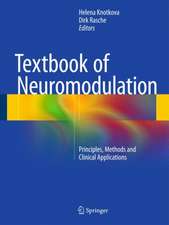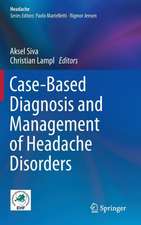Intracranial Pressure: Experimental and Clinical Aspects
Editat de Mario Brock, Hermann Dietzen Limba Engleză Paperback – 26 dec 2011
Preț: 724.50 lei
Preț vechi: 762.64 lei
-5% Nou
Puncte Express: 1087
Preț estimativ în valută:
138.64€ • 148.25$ • 115.59£
138.64€ • 148.25$ • 115.59£
Carte tipărită la comandă
Livrare economică 18 aprilie-02 mai
Preluare comenzi: 021 569.72.76
Specificații
ISBN-13: 9783642654886
ISBN-10: 3642654886
Pagini: 400
Ilustrații: XVI, 384 p.
Dimensiuni: 170 x 244 x 27 mm
Greutate: 0.64 kg
Ediția:Softcover reprint of the original 1st ed. 1972
Editura: Springer Berlin, Heidelberg
Colecția Springer
Locul publicării:Berlin, Heidelberg, Germany
ISBN-10: 3642654886
Pagini: 400
Ilustrații: XVI, 384 p.
Dimensiuni: 170 x 244 x 27 mm
Greutate: 0.64 kg
Ediția:Softcover reprint of the original 1st ed. 1972
Editura: Springer Berlin, Heidelberg
Colecția Springer
Locul publicării:Berlin, Heidelberg, Germany
Public țintă
ResearchDescriere
This volume contains the papers presented at the First International .ijm posium on Intracranial Pressure, held at the Neurosurgical Clinic of the Medizi nische Hochschule Hannover (Hannover Medical School), July 27 to 29, 1972. The texts submitted have been included in their original form whenever possible. The editors have made only minor corrections and rearrangements, since rapid publication was considered to be more important than homoge neity in style. The sessions of this book correspond to the sessions of the sym posium. At the end of each session the reader will find a summary of the topics presented and discussed, especially prepared by the chairman and co-chairman concerned. Three main aspects ofICP were dealt with at the Symposium: Methodology (Sessions 1 and 2), Pathophysiology (Sessions 3 to 6), and Clinical Aspects (Ses sions 7 to 10). Following the symposium a special round table was held on the major topics covered by the meeting. The participants of this round table discussed drafts prepared by T. W. LANGFITT, B. JENNETT and N. LUNDBERG. These contributions have also been included as special chapters at the end of this book, and are believed to reflect the current attitudes as to the topics discussed.
Cuprins
Historical View of the Interest in Intracranial Pressure.- Session 1: Methodology I.- Subdural Pressure Monitoring in Head-Injured Patients.- Long-Time Monitoring of Epidural Pressure in Man.- Passive Radio Telemetry for the Measurement of Intracranial Pressure.- A Modified Equipment for the Continuous Telemetric Monitoring of Epidural or Subdural Pressure.- Influence of Cerebral Vascular Factors on Brain-relative Stiffness.- Some Pecularities of the Passage and Absorption in the Subarachnoid Space at Increased ICP Investigated by Radioisotope Methods.- Comments to Session 1.- Session 2: Methodology.- Comparative Clinical Studies of Epidural and Ventricular Pressure.- Simultaneous Recording of the Epidural and Ventricular Fluid Pressure.- Comparison of Extradural with Intraventricular Pressure in Patients after Head Injury.- A Statistical Approach to Long-Term Monitoring of Intracranial Pressure.- A Method for Statistical Analysis of Intracranial Pressure Recordings.- Comments to Session 2.- Session 3: Cerebral Blood Flow and Metabolism (Experimental).- Some Adjustment Mechanisms of Brain Metabolism during Increased Intracranial Pressure.- Changes of Cerebral Hemodynamics and Energy Metabolism during Increased CSF Pressure and Brain Edema.- rCBF, CMRO2 and Intracranial Pressures Following a Local Cold Injury of the Cortex.- Energy State of the Brain during and after Compression Ischemia.- The Function of Brain Mitochondria after Increased Intracranial Pressure.- Comments to Session 3.- Session 4: Focal Brain Damage (Experimental).- Intracranial Pressure Changes during Experimental Cerebral Infarction.- Intracranial Pressure Changes in Acute Ischaemic Regions of the Primate Hemishere.- Extradural Pressure and Regional Oxygen Availability in Experimental Cerebral Infarction.- Studies on the Water Content of Cerebral Tissues and Intracranial Pressure in Vasogenic Brain Oedema.- Delayed Brain Swelling after X-Irradiation of the Visual Cortex in the Macaca Mulatta.- Comments to Session 4.- Session 5: Brain Compression (Experimental).- The Munro-Kellie Doctrine and the Intracranial Venous Space at the ‘Limit’ of Raised Intracranial Pressure—an Hydrodynamic Experimental Approach.- A Critical Rate of Cerebral Compression.- Irreversible Damage and Cerebral Death in Increased Intracranial Pressure.- Kinetics of Arterial and Venous Hemorrhage in the Skull Cavity.- Regional Cerebral Blood Flow in Increased Intracranial Pressure Produced by Increased Cerebrospinal Fluid Volume, Intracranial Mass and Cerebral Edema.- Perfusion Pressure in Intracranial Hypertension.- The Effects of Intra-Carotid Artery Admini stration of Mannitol on Cerebral Blood Flow and Intracranial Pressure in Experimental Brain Edema.- The Effect of Mannitol on Intracranial Pressure and Cerebral Blood Flow. Clinical and Experimental Observations.- Comments to Session 5.- Session 6: Miscellaneous (Experimental).- Measurement of “Interstitial Fluid” Pressure in the Brain in Dogs.- Brain Tissue Pressure.- Subarachnoid Pressure-Dependent Drug Effects on CSF Transport and Brain Volume.- Cardiorespiratory Interaction during Increased Intracranial Pressure.- The Effect of Hypoxia on the Cushing Response.- Arterial pCO2 Effect at Various Levels of Intracranial Pressure.- Comments to Session 6.- Session 7: Acute Brain Injury (Clinical).- Minute by Minute Intracranial Pressure Monitoring as a Guide to Management of Pathological Intracranial Pressure.- Intraventricular Pressure after Severe Brain Injuries: Prognostic Value and Correlation with Blood Pressure and Jugular Venous Oxygen Tension.- Cardiorespiratory Changes Associated with Plateau Waves in Patients with Head Injury.- Correlative Study of Intracranial and Systemic Arterial Pressures in Neurosurgical Patients.- The Interdependence of Cerebrovascular Autoregulation and Intracranial Pressure.- Recurrent Hemorrhage and Hemostasis in Patients with Ruptured Intracranial Saccular Aneurysm.- The Relationship between Ventricular Fluid Pressure and the Neuropathology of Raised Intracranial Pressure.- Treatment of Cerebral Edema in Man with Spirolactone.- Comments to Session 7.- Session 8: Hydrocephalus (Clinical).- Relations between Cerebrospinal Fluid Pressure (CSFP), Elasticity (E?) of the Dura, and Volume of the CSF (VCSF).- Intracranial Volume/Pressure Relationship during Continuous Monitoring of Ventricular Fluid Pressure.- Computer Modelling of CSF Pressure/Volume and its Relationship to Hydrocephalus.- Long Term Measurement of Extradural Pressure in “Low Pressure” Hydrocephalus.- Ultrastructure of Cortical Capillaries and Cerebral Blood Flow in Low Pressure Hydrocephalus.- Comments to Session 8.- Session 9: Drugs and Anesthetic Agents (Clinical).- Intracranial Pressure during Anesthesia with Ketamine.- Effects of Some Anesthetic Drugs on the Ventricular Fluid Pressure and on the Systemic Blood Pressure Both Arterial and Venous.- Stabilization and Disturbance of Osmoregulation in the Cerebrospinal Fluid.- The Alleviation of Increased Intracranial Pressure by the Chronic Adminitration of Osmotic Agents.- The Role of Vascular and Hemodynamic Factors in the Pathogenesis of Intracranial Hypertension Caused by Focal Lesions of the Brain.- Halothane, Hypocapnia and Cerebrospinal Fluid Pressure in Neurosurgery.- Comments to Session 9.- Session 10: Miscellaneous (Clinical).- Concentration of Acid Monoamine Metabolites in Ventricular CSF of Patients with Posterior Fossa Tumours.- The Valvular Action of the Arnold-Chiari Malformation.- Variations of Intraventricular and Local Brain Pressures during Neurosurgical Procedures.- Complications Due to Prolonged Ventricular Fluid Pressure Recording in Clinical Practice.- The Uses of Intracranial Pressure Monitoring in Clinical Management.- Comments to Session 10.- Concluding Remarks.- Pathophysiology of Increased ICP.- Techniques for Measuring Intracranial Pressure.- Clinical Indications for Measurement of ICP.- Glossary of Definitions, Standards and Abbreviations.












